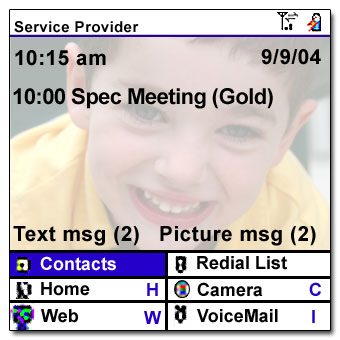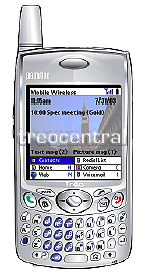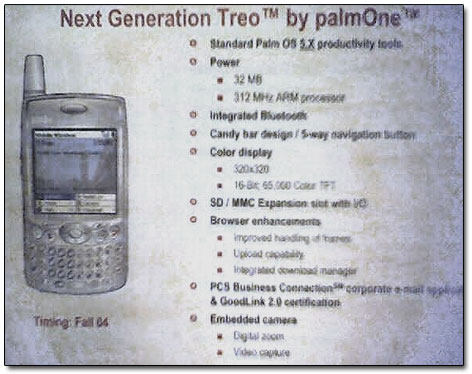�
�
�
�
�
�
�

�
|
|
|
| Sun Jun 27, 2004 - 6:31 PM EDT - By Michael Ducker | |
|
|
|

PalmOne has consistently said that they are interested in creating a family of Treos. They have yet to announce any additional products, but over the last few months TreoCentral has built up an idea of what one of the next generation Treos looks like. We have held off publishing this information as we attempted to gather further details about this next generation Treo. However, today an image featuring the new Treo was posted to our forums, and within hours many websites (engadget, palminfocenter) were linking to it. The cat was out of the bag. So without further ado, here is the full scoop on the 4th generation Treo.
We do not know the final name for this next generation Treo - nobody seems to know. There have been several outstanding rumors naming it the Treo 610. Still, we have also had reports that it will be named the Treo 660. As we could not confirm either name, we will stick to the codename of this next generation Treo: Ace.
Presenting the Treo Ace
The Treo Ace is a substantial revision to the Treo line. According to one source, "the cool factor is about the same between Ace and the 600 as it was between the 600 and the 300. If anyone remembers their first experience with the 600, seeing and holding the Treo Ace gives the same gasp impression that you got when you first held the 600."
To the top right is a rendering of the Treo Ace. While it looks similar to the Treo 600, the new Treo is slightly smaller. The dimensions themselves did not change much - the Treo Ace is a couple millimeters thinner, shorter, and less wide. However, we are told that the small changes in size are striking when you hold it. The Treo Ace is also slightly rounder in shape than the Treo 600.
The Specifics:

The Treo Ace is scheduled to ship in Fall 2004. But depending on how development, and the production rampup goes, this could be as early as July or as late as Christmas 2004. We have not received any details on pricing or on the official availability of the device..
The Treo Ace will eventually be sold through all of PalmOne's carrier partners, both CDMA and GSM. Sprint, most likely, will be launching the CDMA version, and AT&T will possibly launch the GSM version. Sprint recently announced their plans for EVDO technology. On the GSM side, Cingular (New owner of AT&T) has launched its high speed EDGE technology. It is unknown if the Treo Ace will support either of these next generation data standards.
It is interesting to note that the specifications of the Treo Ace are very similar to the recently launched Zire 72. The Zire 72 has an Intel PXA270 312 Mhz Xscale processor, 32 MB RAM, built in bluetooth, a 320x320 16 bit screen, and a built in 1.2 megapixel camera. But, while similar, the architectures are most likely very different. Handspring engineers for the most part designed the Treo Ace, while the Zire 72 is a carryover from Palm employees. The two groups of engineers most likely designed things very differently, and it will probably be another revision before we see designs that go between Zire, Tungsten, and Treo lines.
Lastly, due to a recent new rule (pdf) from the FCC, it is much easier for companies to request that their entire application for FCC certification be held confidential until the products public release. Therefore, it is unlikely that we will see an FCC leak of external photos, internal photos, or user manuals of the Treo Ace, before PalmOne announces it. The FCC's OET previously leaked information on the Treo 600, Treo 300, and Treo 180.
As the release of the Treo Ace is several many months away, these
specifications are likely to change. We do not recommend that you base any
purchasing decisions on the information reported above, until confirmed by
palmOne.

Copyright 1999-2016 TreoCentral. All rights reserved :
Terms of Use : Privacy Policy
TREO and TreoCentral are trademarks or registered trademarks of palm, Inc. in the United States and other countries;
the TreoCentral mark and domain name are used under license from palm, Inc.
The views expressed on this website are solely those of the proprietor, or
contributors to the site, and do not necessarily reflect the views of palm, Inc.
Read Merciful by Casey Adolfsson